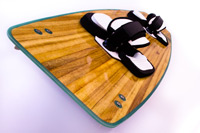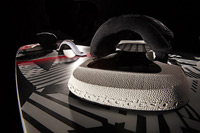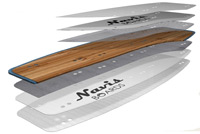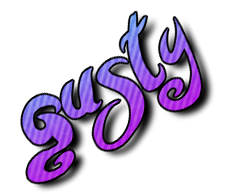Buy kiteboarding board – which one to choose?
A common question I get from people that recently took a kiteboarding course is not only which kite they should buy, but also which kiteboarding board. I put together this little guide to help you out deciding which board to buy and it will hopefully give you an idea of what to look for when choosing a good board for you.
The one that asks in a forum will probably hear terms such as “rocker”, “flex”, “outline”, “rail”, etc… details that don’t matter much for the one that just wants a decent board to start with and who wants a board that will help him/her to easily progress in a fast way. As in many other contexts size is the most important parameter. Length and width determines the size of the board. Generally speaking it is easier to learn kiteboarding with a bigger board since a big board entails many advantages for the beginner. Most important is the buoyancy. A bigger board delivers much more buoyancy than a small board thanks to its larger area. This does not only make it easier for you as a beginner to stand up on the board and plane but it also means that it will be easier for you to keep riding on the water when the wind is decreasing or if the traction force in the kite decreases (something that often happens due to a beginners not yet fully developed skills to control the kite). The buoyancy in a large board will in other words help you stay upright on the board and despite your lack of skills. The buoyancy also means that you will not need as much power in the kite as if you would ride with a smaller board and you can hence take a smaller kite. To be able to ride with less power in the kite will build confidence and in an early stage really give your progression a boost.
 The primary disadvantages with a big board has to do with the feeling, a big board plainly feels… BIG! A big board is harder to manouver and doesn’t feel dynamic. Moreover a big board has a tendency to get “stuck” in the water when it’s a bit choppy. The board can also become unstable in higher speeds since the board will bounce rather than cut through small waves. As you begin to jump you will also notice that the heavy weight from a big board might be good for your abs, but not necessarily helpful for your technique… Most people will due to these reasons soon look for a smaller board as they become better kitesurfers.
The primary disadvantages with a big board has to do with the feeling, a big board plainly feels… BIG! A big board is harder to manouver and doesn’t feel dynamic. Moreover a big board has a tendency to get “stuck” in the water when it’s a bit choppy. The board can also become unstable in higher speeds since the board will bounce rather than cut through small waves. As you begin to jump you will also notice that the heavy weight from a big board might be good for your abs, but not necessarily helpful for your technique… Most people will due to these reasons soon look for a smaller board as they become better kitesurfers.
This leads us directly to the main problem with buying a big board… you will relatively fast outgrow it. How long time this takes of course depends on how much you practise, still I would recommend you to start look for a smaller board as you have reach a level where you’re about start jumping. People choose to see this problem from different perspectives. Some buy a big board just for the early learning of kiteboarding before they upgrade to a smaller board as they feel ready. The bigger board can then either be sold or used as a lightwind board. As already mentioned the higher buoyancy that comes with a big board means less required wind to get you up riding why it’s excellent to use it at lightwind days when it’s not even possible to ride with a small board. However, many beginners choose to buy a board aimed towards a more experienced rider and accept the fact that it will take them longer time to learn kiteboarding and perhaps several years before they reach a level where they actually can take advantage of the full potential in a smaller board.
I’d like to mention an often unstated advantage of owning two boards with widely different buoyancy as an alternative to choosing between a big board or a small board. With two boards you’ll not have to spend as much money on kites (that are significantly more expensive and easier to break) while you increase the wind range for the kite(s) that you possess. Suppose that you own two kites, one 8m and one 12m, and one 135cm long board. The wind range for these two kites together span from about 7 – 14 m/s (depending on your weight and skills). Now buy a second board of 150 cm in length and you’ll increase the wind range for both of your kites. You’ll be able to ride both the 8m and the 12m kite in weaker wind if you take the bigger board, which means that you can have more sessions on the water. A big board and a small board also means that you can switch your two kites to a 7m kite and a 13m kite since you have increased the wind range for both of kites. Suddenly it has become possible for you to get out kiteboarding in everything from about 6-18 m/s (estimated numbers which don’t exactly meet the reality, I just took them from my head to illustrate the difference). You would probably have to buy a third kite, for instance a 10m kite, to be able to cover this wind range solely with your 135cm board. A kite is more expensive than a board and loses its value faster.
No matter if you decide to buy one or two boards, it also comes down to your own personal style and preferences. Some individuals prefer to have the perfect sized kite for any given day. If this is the case for you, then 3 kites and one board is to be recommended. For the one that wants to be able to have as many sessions as possible to the lowest price, then 2 boards and 2 kites is a good choice.
So how big is sufficient for a beginner? You can generally speaking say that a big board is anything between 140 to 160 centimeters. Bigger than this and you might as well use a canoe for a board… Anything smaller than 140 cm and we’re looking in the territory for small boards. The bigger and heavier you are, the bigger board you’ll want to look for within this range. As a five feet woman a 140 cm board is enough while a 100 kilos bodybuilder probably is better of with a 160 cm board. There is no such thing as the perfect size and it vary from person to person so don’t bother arguing with yourself wether you should go for a 145 or 146 cm board, just buy one and make sure to get out on the water instead. After a session or two you will gain experience that for sure will compensate for board differences counted in centimeters. I’d like to tell you some last words that will make life easier for you before we’re heading over to terms used by people in the forums.
 Fins do have a very high impact on the characteristics of a board. The one who doubts this can remove the fins from his board and see what happens. Bigger fins will give you more stable feeling on the water and it will be easier to ride upwind. From these reasons I’d like to recommend fins that are at least 5 centimeters in height. Once again, as you feel comfortable with your board then nothing stops you from switching the fins to another size, it’s a fun way to experiment with your riding style without spending a fortune.
Fins do have a very high impact on the characteristics of a board. The one who doubts this can remove the fins from his board and see what happens. Bigger fins will give you more stable feeling on the water and it will be easier to ride upwind. From these reasons I’d like to recommend fins that are at least 5 centimeters in height. Once again, as you feel comfortable with your board then nothing stops you from switching the fins to another size, it’s a fun way to experiment with your riding style without spending a fortune.
 The Footpads and the footstraps should be comfortable and fit your feet without any sharp edges or pieces that painfully can scrape or press against your feet. Make sure that your feet sit tight on the pads so that board doesn’t come off as you’re riding, but still lose enough so that you can kick off the board in case you end up in a situation where a board stuck on your feet might leave you at the hospital with spikes in a plastered knee. Last, but not least, make sure that the board is equipped with a comfortable and solid handle. The procedure itself with getting the board on your feet will become so much easier with a good board handle, not to mention just picking up the board from the ground.
The Footpads and the footstraps should be comfortable and fit your feet without any sharp edges or pieces that painfully can scrape or press against your feet. Make sure that your feet sit tight on the pads so that board doesn’t come off as you’re riding, but still lose enough so that you can kick off the board in case you end up in a situation where a board stuck on your feet might leave you at the hospital with spikes in a plastered knee. Last, but not least, make sure that the board is equipped with a comfortable and solid handle. The procedure itself with getting the board on your feet will become so much easier with a good board handle, not to mention just picking up the board from the ground.
Board terms
So what the hell are they actually talking about in the forums?? Let’s straighten out a term or two 🙂
Rocker
By rocker we mean the curve line on the bottom of the board, from end to end. This term is used for twintip boards (the most common board type among kitesurfers) since these boards are fully symmetrical. The shape of the rocker give certain characteristics to a board. A flatter rocker gives a faster board while a more convex curve makes a board easier to manouver. Some boards are equipped with partly convex rocker that is measured from rail to rail.
A board with a flat rocker makes it easier to ride upwind, but harder to manouver in the turns, something which can be a disadvantage (especially for the one who is riding waves).
Outline
The outline means two things: the maximum width of the board and the shape of the outline. Both factors affect the board when it comes to responsiveness, upwind ability, balance and stability. A board with a more curved outline will turn faster, but gives less good stability and balance. A board with a straighter outline gives more grip which makes it easier to ride upwind.
Width
Wide boards can be shorter while they allow heavier people to surf them efficiently. No matter the board length, a wide board facilitates upwind abilities while you can keep the speed effortless. A wide board gives better stability as you land tricks and transitions and it’s better than a narrow board in gusty or light wind.
Rail
The rail affect a boards steering ability. Its volume and shape form the edge of the board with which we cut through the water. A sharp edge increases the performance and makes it easier to control the power, but a sharp edge might also make it harder for the beginner to handle the speed due to its good response. Boards with sharp edges are ideal for powerful kites in flat water. A rounder edge gives the board a softer feeling and makes it more forgiving, better for waves and beginner while it also lower the risk for injuries caused by the rail.
Flex
The flex or flexibility affects the characteristics in a board during different circumstances. A more stiff board is ideal for flat water and great for riding upwind and to jump with. Though it will be less good in choppy water since it doesn’t absorb shocks in the same way as a more flexible board which in turn will make the board less controllable. Hence, a flexible board is better in hoppy water, especially if the board not only is flexible from tip to tip but also crossover from side to side.
Material
 A board often consists of a wooden core in some kind of flexible and durable wood. The core is in turn enhanced with fiberglass that also allows the board to be twisted and bended. The next layer can consist of a layer where the graphics are printed. The topsheet of a board consists of a thin layer that makes the board rock hard and resistant to water as well as to UV light. The number of layers in a board varies depending on how it’s manufactured, but the principal in how to build a board is the same for all boards on the market. You can see an example of how a board is built-up by clicking on the image to the left.
A board often consists of a wooden core in some kind of flexible and durable wood. The core is in turn enhanced with fiberglass that also allows the board to be twisted and bended. The next layer can consist of a layer where the graphics are printed. The topsheet of a board consists of a thin layer that makes the board rock hard and resistant to water as well as to UV light. The number of layers in a board varies depending on how it’s manufactured, but the principal in how to build a board is the same for all boards on the market. You can see an example of how a board is built-up by clicking on the image to the left.
Buy second hand?
You can save hundreds of dollars by buying a second hand board. A new board costs anything from about $300 – $1000+ depending on its quality. You can find a good second hand board for about $200. Buy second hand and you might find some minor scratches on the bottom of the board, something that is almost unavoidably to get if you’re kiteboarding a lot. Scratches are however not something that makes the board worse in any way. However, what is good to check are the following:
- The Rail. Check for holes or cracks that go deep into the core, water might penetrate all the way in to the wooden fibres.
- Under the footpads. Lift the heal of the footpad and inspect the condition underneath it. If the fibres are soft or if the material is compressed then the board can be in poor condition and might even break at heavy stresses.
- Screw holes. The most exposed screw holes are of course those where you mount the footpads. Pull gently in the pads to check that the screws really sit in the screw holes.
- The handle. There are different types of material for the handle. Plastic and other composites are common, which usually are really solid and endurable. The handle can also consist of a steel core with rubber laminas around it. The glue in these laminas tend to comes lose with time and eventually only the steel core is left. Check the laminas to make sure that they still are glued to each other.
In case you managed to read all the way to this point then you have hopefully gotten a better understanding for which board to aim for. If you still have question or thoughts don’t hesitate to throw me a mail and I’ll get back to you asap! 🙂
/Gustav – IKO Kiteboarding Instructor


